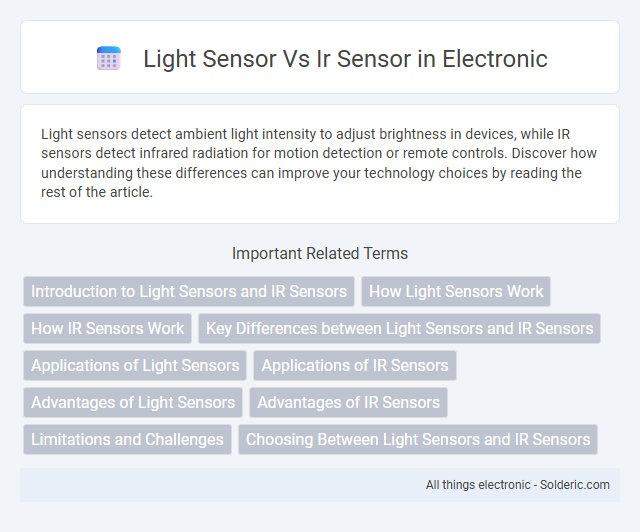Light sensors detect ambient light intensity to adjust brightness in devices, while IR sensors detect infrared radiation for motion detection or remote controls. Discover how understanding these differences can improve your technology choices by reading the rest of the article.
Comparison Table
| Feature | Light Sensor | IR Sensor |
|---|---|---|
| Function | Detects visible light intensity | Detects infrared radiation |
| Wavelength Range | 400-700 nm (visible spectrum) | 700 nm to 1 mm (infrared spectrum) |
| Common Types | Photodiodes, phototransistors, LDRs | Proximity sensors, thermal sensors, IR receivers |
| Applications | Ambient light detection, brightness control | Remote controls, motion detection, obstacle avoidance |
| Output | Analog or digital signal proportional to light intensity | Analog or digital signal in presence of IR radiation |
| Operating Environment | Requires visible light environment | Works in dark or light conditions |
| Cost | Generally low cost | Variable cost depending on complexity |
Introduction to Light Sensors and IR Sensors
Light sensors detect visible light intensity to measure ambient lighting, while IR sensors detect infrared radiation primarily emitted by heat sources. These sensors differ in wavelength sensitivity: light sensors operate within the visible spectrum (400-700 nm), whereas IR sensors detect wavelengths beyond visible light, typically 700 nm to 1 mm. Your choice between them depends on application needs such as ambient light detection or proximity and motion sensing through heat signatures.
How Light Sensors Work
Light sensors detect ambient light by measuring the intensity of visible or ultraviolet light using photodiodes or phototransistors, converting light into electrical signals. Infrared (IR) sensors specifically detect infrared radiation, capturing heat emitted by objects rather than visible light, which makes them effective for motion detection and proximity sensing. Your choice depends on the application: use light sensors for adjusting screen brightness or lighting controls, while IR sensors serve better for obstacle detection and remote controls.
How IR Sensors Work
IR sensors detect infrared radiation emitted by objects, converting the energy into an electrical signal to measure heat or movement. These sensors use photodiodes or phototransistors sensitive to IR wavelengths, enabling your device to detect proximity, gestures, or environmental changes. Unlike light sensors that respond to visible light intensity, IR sensors operate primarily in the infrared spectrum for precise detection in various applications.
Key Differences between Light Sensors and IR Sensors
Light sensors detect visible light intensity across a broad spectrum, enabling devices to adjust screen brightness or trigger alarms in varying illumination conditions. IR sensors specifically detect infrared radiation, often used in remote controls, motion detection, and night vision applications. Your choice depends on whether measuring ambient visible light or detecting heat signatures and IR signals is required for accurate functionality.
Applications of Light Sensors
Light sensors are widely used in applications such as automatic lighting control, where they adjust indoor or outdoor lighting based on ambient light levels to conserve energy. They play a crucial role in smartphone screens by optimizing brightness for better visibility and battery efficiency. Your smart home security system can also utilize light sensors to detect changes in lighting conditions, enhancing surveillance accuracy.
Applications of IR Sensors
IR sensors are widely used in remote control devices, night-vision equipment, and smoke detectors due to their ability to detect infrared radiation emitted by objects. Industrial applications include proximity sensing, motion detection, and temperature measurement, where IR sensors provide non-contact monitoring. In healthcare, IR sensors assist in pulse oximetry and thermography, enabling accurate vital signs tracking and fever detection.
Advantages of Light Sensors
Light sensors offer precise measurement of ambient light intensity, enabling accurate automatic adjustments in devices such as smartphones and lighting systems. These sensors consume low power and provide real-time data, improving energy efficiency and user comfort. Your environment benefits from enhanced performance in applications like display brightness control and smart home automation.
Advantages of IR Sensors
IR sensors offer precise object detection and motion sensing capabilities, making them ideal for applications requiring accurate distance measurement and presence detection. They perform well in low-light or complete darkness, unlike light sensors that rely on ambient light levels. Your projects benefit from IR sensors' ability to detect heat signatures and provide reliable data regardless of lighting conditions.
Limitations and Challenges
Light sensors face challenges such as sensitivity to ambient light interference and limited range in detecting subtle changes in illumination. IR sensors struggle with obstacles including interference from other infrared sources, reduced accuracy in bright sunlight, and limited detection distance for precise object recognition. Both sensors require careful calibration to minimize false readings and ensure reliable performance in varying environmental conditions.
Choosing Between Light Sensors and IR Sensors
Choosing between light sensors and IR sensors depends on the specific application requirements such as detection range, wavelength sensitivity, and environmental conditions. Light sensors, including photodiodes and phototransistors, primarily detect visible light intensity and are ideal for ambient light measurement and display brightness control. IR sensors, operating in the infrared spectrum, excel in motion detection, proximity sensing, and obstacle avoidance by detecting IR radiation emitted or reflected by objects.
light sensor vs ir sensor Infographic

 solderic.com
solderic.com